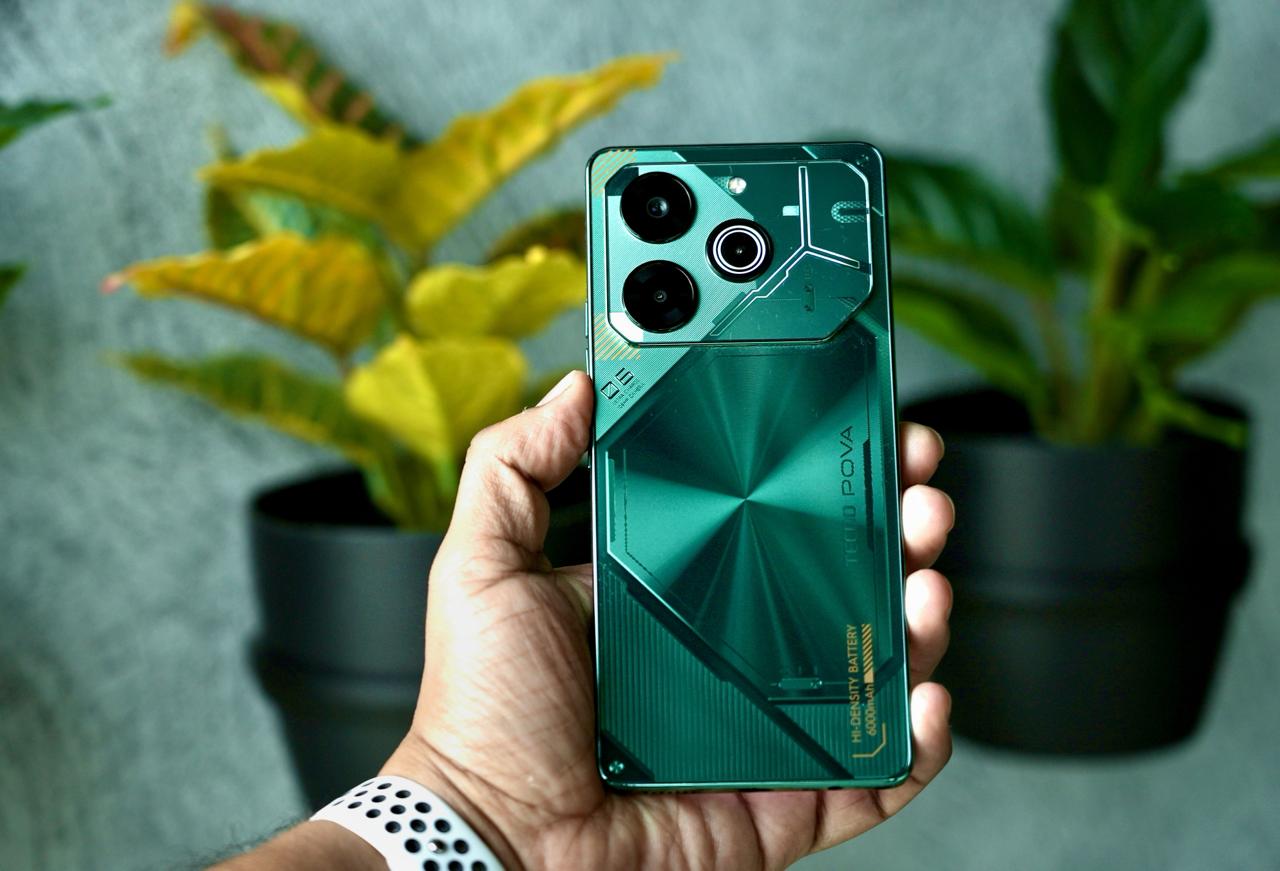The Tecno Pova 6 Pro 5G is a mid-range smartphone with impressive features, such as a 120Hz AMOLED display, a powerful 108-megapixel primary camera, and a huge 6,000mAh battery with fast charging. The most striking feature is the back panel, which was inspired by a motherboard. The new LED design features over 200 LEDs and 100+ customization options. However, before making a purchase, it’s important to consider a few trade-offs.
DESIGN
The Tecno Pova 6 Pro 5G is a smartphone that strikes a balance between having a powerful battery and a slim design, while also incorporating some eye-catching elements. Despite having a massive 6,000mAh battery, the phone has an impressively slim profile of just 7.88mm. This makes it surprisingly comfortable to hold in one hand, especially when compared to other phones with similar battery capacities. Also, at just 195g, the phone is lightweight and still looks good.
Instead of using the typical glass or plain plastic back design, Tecno has opted for a textured design that looks cool. The phone is available in Comet Green or Meteorite Grey, and the most significant feature apart from the back panel is the customizable LED strip that runs alongside the rear camera module. This strip can light up notifications, charging status, or even while gaming, adding a touch of personalization and a light show. However, it may be seen as gimmicky to some users while others may find it appealing.
The front of the phone sports a large 6.78-inch AMOLED display with a punch-hole cutout for the front-facing camera. The bezels are relatively thin, offering an excellent screen-to-body ratio for an immersive viewing experience. The rear camera module houses the triple-lens setup and the LED strip. It protrudes slightly from the back but shouldn’t cause significant wobbling when placed on a flat surface. Surprisingly, the Pova 6 Pro has a 3.5mm headphone jack, which is rare to see on a smartphone. There is even a dedicated microSD card slot for storage expansion.
The phone has an IP53 rating, which means it’s resistant to dust and can withstand light splashes. However, it’s not fully waterproof, so it’s best to avoid using it near pools or in heavy rain.
PERFORMANCE
The Tecno Pova 6 Pro 5G is equipped with a MediaTek Dimensity 6080 processor, which works in conjunction with 8GB or 12GB of RAM, depending on the model you choose. This allows for effortless handling of daily activities such as web browsing, social media, and video streaming. App loading times are reasonable, and multitasking is seamless. The base model offers a generous 256GB of storage, which should suffice for most users, but can be further expanded with a microSD card if needed.
Tecno’s HiOS 14 skin, which is layered on top of Android 14, may take some time to get used to for users who are accustomed to standard Android. Although it offers some additional features, it can feel bloated at times. Upgrades may take longer compared to established brands. It even has its own branded store and apps, along with other pre-installed apps that can make the device UI appear cluttered. Fortunately, some of the pre-installed apps can be uninstalled, although it can be a tedious task for a new user.
The phone can handle most casual games like Asphalt 9 without any problems. However, more demanding games like BGMI or Call of Duty Warzone with high graphics settings may experience some frame drops or stutters. If you’re a hardcore gamer, there may be better options available with more powerful processors.
Although benchmarks are not the only indication of processing power, they provide a general idea of a phone’s performance. The Dimensity 6080 scores modestly in benchmarks compared to the latest flagship processors. However, it is comfortably situated within the mid-range segment, offering similar performance to other phones in its price range.
After using the phone for a week, it manages heat dissipation well during everyday tasks. However, under heavy loads like gaming or prolonged video editing using VN editor, the phone may get warm to the touch.
CAMERA
The Tecno Pova 6 Pro 5G is a smartphone equipped with a triple-lens rear camera system. The high-resolution primary sensor is the standout feature with an impressive 108-megapixel. This means that photos taken with this phone should have exceptional detail, particularly in well-lit environments. The primary sensor is accompanied by two 2-megapixel sensors, one for depth information and the other with an unspecified purpose. These additional sensors are typically found in budget phones and do not add much to image quality.
In terms of daylight performance, the 108-megapixel sensor can capture detailed photos with accurate color reproduction, although there may be slight processing issues that result in a loss of sharpness in some areas. As with most mid-range phones, low-light performance can be a challenge. Photos may appear noisy and lacking in detail. Tecno’s night mode can help somewhat, but it is not as effective as high-end phones. The phone can record videos up to 1440p resolution at 30fps, which is sufficient for basic recording.
The 32MP front-facing camera can capture decent selfies with clear details and accurate colors in well-lit environments. However, in low-light situations, the camera may struggle to produce good quality images, resulting in grainy or blurry photos.
VERDICT
The Tecno Pova 6 Pro 5G is an excellent choice for those who are on a budget and want a phone with a long-lasting battery, a smooth display, and a unique techie design. The camera system is good, and the performance is sufficient for most everyday tasks. However, the slightly outdated processor prevent it from being an outstanding phone.
